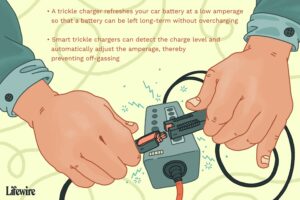Curious about how long lithium ion batteries last? Wondering how to make the most of your battery’s lifespan? Well, you’re in the right place! In this article, we’ll delve into the fascinating world of lithium ion batteries, exploring their longevity and providing you with valuable tips to extend their lifespan. Whether you’re powering your smartphone, laptop, or electric vehicle, understanding how long lithium ion batteries can endure is crucial for optimizing their performance. So, let’s jump right in and uncover the mysteries behind how long lithium ion batteries last.
How Long Does a Lithium-Ion Battery Last?
Lithium-ion batteries have become an essential power source for various devices, from smartphones and laptops to electric vehicles and power tools. Understanding how long a lithium-ion battery lasts is crucial for determining the battery life of your devices and planning for replacements or recharges. In this article, we will delve into the factors that influence the lifespan of lithium-ion batteries and provide practical tips for prolonging their longevity.
1. Capacity Fade: The Decline in Battery Capacity
One of the primary concerns with lithium-ion batteries is the gradual decrease in their capacity over time. This decline is known as capacity fade, and it occurs due to several factors. Let’s explore them in detail:
A. Calendar Aging
Calendar aging refers to the natural degradation of a battery over time, even when it is not in use. This phenomenon affects lithium-ion batteries because of the chemical processes occurring within them. As time passes, the battery’s ability to hold a charge decreases, resulting in reduced total capacity.
B. Depth of Discharge (DoD)
The depth of discharge (DoD) is another crucial factor affecting the lifespan of a lithium-ion battery. DoD refers to the amount of capacity utilized before recharging the battery. When a battery is discharged completely, it undergoes more stress and wears out faster than if it were discharged only partially.
- High DoD (e.g., 100%): This stresses the battery significantly and leads to faster degradation.
- Low DoD (e.g., 20-30%): This reduces the wear on the battery, prolonging its lifespan.
C. Temperature
Temperature plays a significant role in the performance and longevity of lithium-ion batteries. Extreme temperatures, both hot and cold, can accelerate the rate of capacity fade. High temperatures increase chemical reactions within the battery, causing it to age more rapidly. Conversely, freezing temperatures can negatively impact the battery’s ability to deliver power.
2. Factors Affecting Lithium-Ion Battery Lifespan
Now that we understand capacity fade, let’s explore the key factors that influence the overall lifespan of a lithium-ion battery:
A. Charge Cycles
A charge cycle refers to the process of discharging a battery from 100% to a specific DoD and then recharging it back to 100%. Lithium-ion batteries do have a limited number of charge cycles before experiencing a notable decline in capacity. The number of charge cycles a battery can endure depends on several factors, including the DoD, temperature, and battery management. Typically, lithium-ion batteries can withstand around 300-500 charge cycles before their capacity diminishes significantly.
B. Battery Management Systems (BMS)
Battery management systems (BMS) are crucial for preserving the lifespan of lithium-ion batteries. These systems monitor and control various aspects of battery operation to ensure optimal charging, discharging, and temperature regulation. A well-designed BMS can prevent overcharging, overheating, and other potentially damaging scenarios that could shorten the battery’s lifespan.
C. Manufacturing Quality
The quality of the battery itself also affects its lifespan. Batteries from reputable manufacturers often undergo rigorous testing and quality control measures to ensure they meet specific standards. Higher-quality batteries tend to have better performance and longevity compared to those of lower quality.
D. Usage Patterns
How you use your device and battery can significantly impact its lifespan. Certain usage patterns can accelerate capacity fade, while others can help prolong the battery’s life. Here are some tips:
- Avoid frequent full discharges and instead opt for partial discharges.
- Keep the battery at moderate temperatures, avoiding extreme heat or cold.
- Avoid leaving the battery at very low or very high charge levels for extended periods.
3. Prolonging the Lifespan of Lithium-Ion Batteries
While lithium-ion batteries do have a limited lifespan, there are steps you can take to maximize their longevity. Here are some practical tips:
A. Avoid Extreme Temperatures
Exposure to extreme temperatures can significantly impact the capacity and lifespan of a lithium-ion battery. Whenever possible, keep your devices and batteries in a moderate temperature range (typically between 20°C and 25°C or 68°F and 77°F).
B. Optimize Charging Habits
Pay attention to your charging habits to optimize the lifespan of your lithium-ion battery. Consider the following best practices:
- Avoid deep discharges. Instead, recharge the battery when it reaches around 20-30% capacity.
- Do not leave your battery fully discharged for extended periods, as this can lead to capacity loss.
- Avoid overcharging. Once the battery reaches 100%, disconnect it from the charger to prevent overcharging, which can degrade the battery over time.
C. Store Batteries Properly
If you need to store lithium-ion batteries for an extended period, it’s essential to follow proper storage guidelines to maintain their health:
- Store the batteries in a cool, dry place with temperatures between 20°C and 25°C (68°F and 77°F).
- Ensure the battery has a partial charge (around 50%) before storing it. Completely discharging or fully charging the battery before storage can lead to capacity loss.
- Check the charge level periodically during storage and recharge if necessary to prevent self-discharge.
The lifespan of a lithium-ion battery is influenced by several factors, including capacity fade over time, depth of discharge, temperature, charge cycles, battery management systems, manufacturing quality, and usage patterns. While these batteries do have a limited lifespan, proper care and optimal usage habits can extend their longevity. By following the tips and best practices mentioned in this article, you can make the most of your lithium-ion batteries, ensuring optimal performance and durability for your devices.
Frequently Asked Questions
How long does a lithium-ion battery last?
A lithium-ion battery typically lasts for 2 to 3 years with regular use. However, the lifespan of the battery can vary depending on several factors such as usage patterns, charging habits, and environmental conditions.
What factors can affect the lifespan of a lithium-ion battery?
Several factors can impact the lifespan of a lithium-ion battery:
- Usage patterns: Constant heavy usage or frequent deep discharges can shorten the battery life.
- Charging habits: Overcharging or leaving the battery at extremely high or low charge levels can degrade its capacity over time.
- Environmental conditions: Exposure to high temperatures, excessive humidity, or extreme cold can reduce the battery’s lifespan.
Can I extend the lifespan of my lithium-ion battery?
While it is not possible to significantly extend the natural lifespan of a lithium-ion battery, you can adopt certain practices to help prolong its overall life:
- Avoid frequent deep discharges and instead recharge the battery before it gets too low.
- Avoid exposing the battery to extreme temperatures.
- Use the manufacturer-recommended charger and charging methods.
- Store the battery in a cool and dry place when not in use for an extended period.
What signs indicate that a lithium-ion battery needs replacement?
Several signs indicate that a lithium-ion battery may need to be replaced:
- A significant decrease in battery life, with the device not lasting as long between charges.
- The battery swelling or bulging.
- The battery not holding a charge and draining quickly even after a full charge.
- The battery temperature becoming unusually hot during charging or use.
Can a lithium-ion battery be overcharged?
Modern lithium-ion batteries are designed with built-in protection circuits that prevent overcharging. Once the battery reaches its full charge, the circuit stops the charging process, eliminating the risk of overcharging.
Is it okay to leave a device plugged in after the lithium-ion battery reaches 100% charge?
Yes, it is generally safe to leave a device plugged in after the lithium-ion battery reaches 100% charge. Most devices are designed to stop charging the battery and instead rely on the power source directly, preventing continuous charging and potential overcharging of the battery.
Final Thoughts
Lithium-ion batteries have become the go-to power source for a wide range of electronic devices. These batteries offer a reliable and long-lasting energy solution. On average, a lithium-ion battery can last between 2 to 10 years, depending on various factors such as usage patterns, temperature, and charging habits. With proper care and maintenance, you can maximize the lifespan of your lithium-ion battery. Regularly charging it to around 80% of its capacity, avoiding extreme temperatures, and storing it in a cool and dry place can help prolong its life. So, if you’re wondering how long lithium-ion batteries last, keep these factors in mind to ensure optimal performance and longevity.


